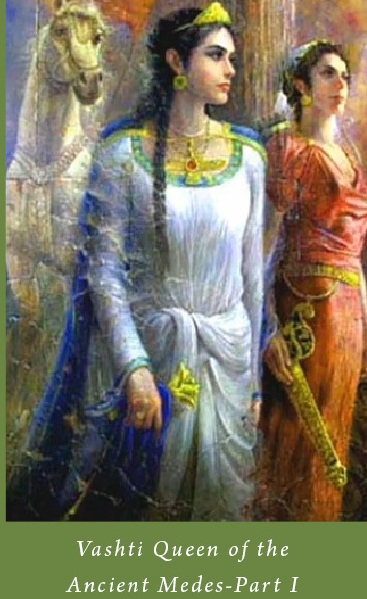By Alison Buckley (Author) and Hamma Mirwaisi (Author)
The Kurdish women guerrillas who fight to regain the land whose theft was initiated on that fateful day when Vashti refused to come before the king.
Co regent of the Median and Babylonian Empires, daughter of General Cicataxma, chosen by her father-in-law Shahan Shah Cyaxares, Vashti, Queen of the Medes walks the long corridor to the garden court of King Astyages’ (Ahasuerus’) palace. Waiting for her is her drunken husband, cavorting riotously with his concubines, foreign visitors and even the servants. Never would she expose herself in such a way as he had demanded. Trapped, the net set by her enemies is closing around her, the gaping mouth of its jade studded door opening before her.
How had their marriage come to this? Aeons ago Astyages had drawn her into the shelter of the fragrant pine trees of the hunting grounds during a late summer storm, where they had finally come together after tempestuous years of other loves and imperial demands.
Now her other passion, the Median Empire, carefully entrusted to her is under threat. Does the king’s unexpected order signify a plot to also undermine the Babylonian Empire, which the Median monarchs now administer for his sister Queen Amytis following her husband King Nebuchadnezzar’s fall into insanity?
The magi had warned her of Asytages’ deterioration over the last six months of celebrations of his imperial grandeur.
Ashtizai, her lifelong maid and blood sister, squeezes her hand. Will this be the last time she crosses the threshold of the garden court?
In 582 BCE when she was illegally deposed by her husband, King Ahasuerus (Astyages) Queen Vashti of Media ruled an empire from India to western Turkey and from Georgia to the Sudan. A descendent of Queen Nefertiti, grand step-mother of Cyrus the Great and daughter of the Medes’ leading general, she was entrusted with the fostering of the seminal Aryan civilisation by her father-in-law King Cyaxares, who brought the Median Empire from its tribal origins to a parallel and allied power to King Nebuchadnezzar’s Babylon.
Denied her rightful as the first feminist place in history Vashti has previously been relegated to secondary importance behind Esther of Purim and biblical fame. Now knew research has thrown light on the pivotal significance of her downfall for Middle Eastern history, which heralded the two and a half thousand year subjection of her Aryan civilisation to Persia, Judea, Greece, Rome and later Arabia and Turks. Emerging from the distortions and deletions of their politically and culturally dominant discourses Vashti has no ancient rival and can only be compared to present day stateswomen such as Hilary Clinton and Queen Elizabeth of England.
The recent assassination of three women Kurdish activists in Paris highlights further the relevance the historical novel Vashti, Queen of the Ancient Medes.Today her indomitable spirit lives on in her descendants,the Kurdish women guerrillas who fight to regain the land whose theft was initiated on that fateful day when Vashti refused to come before the king.



